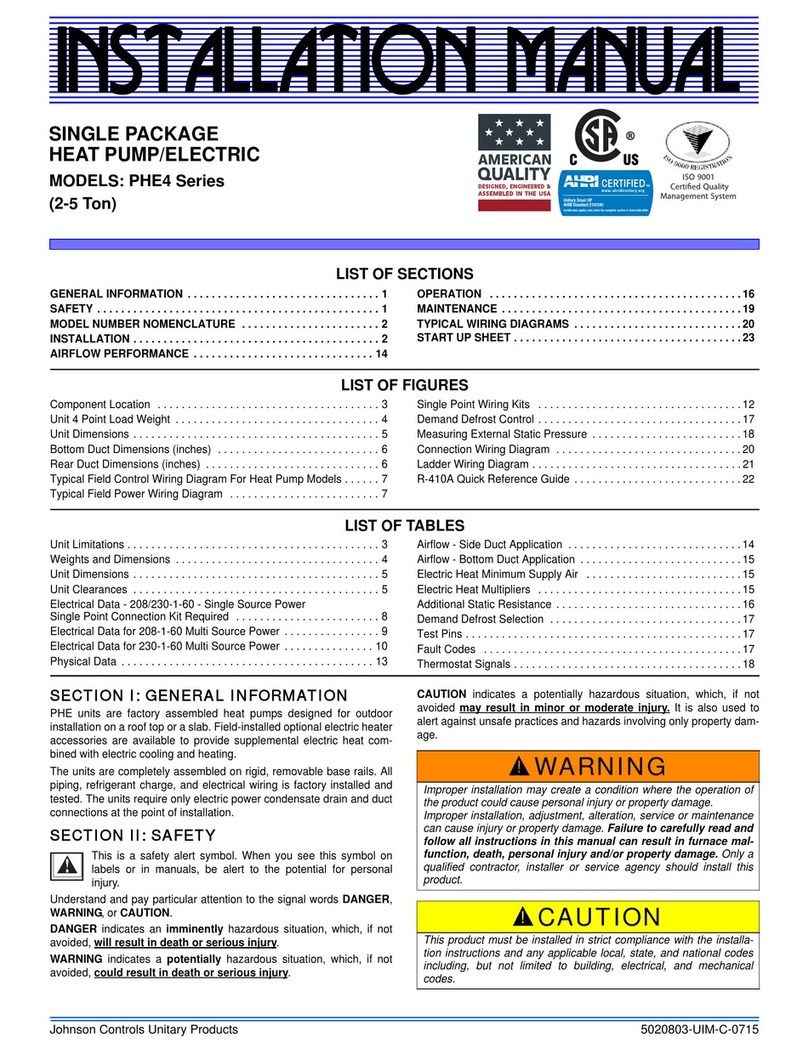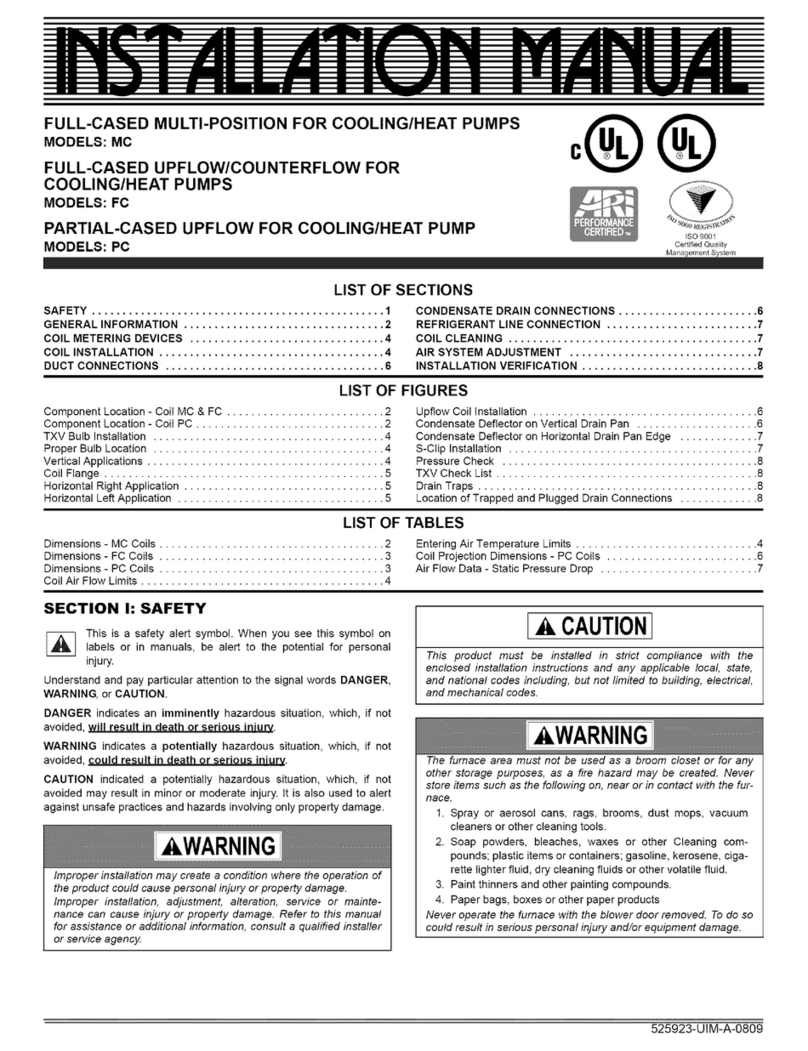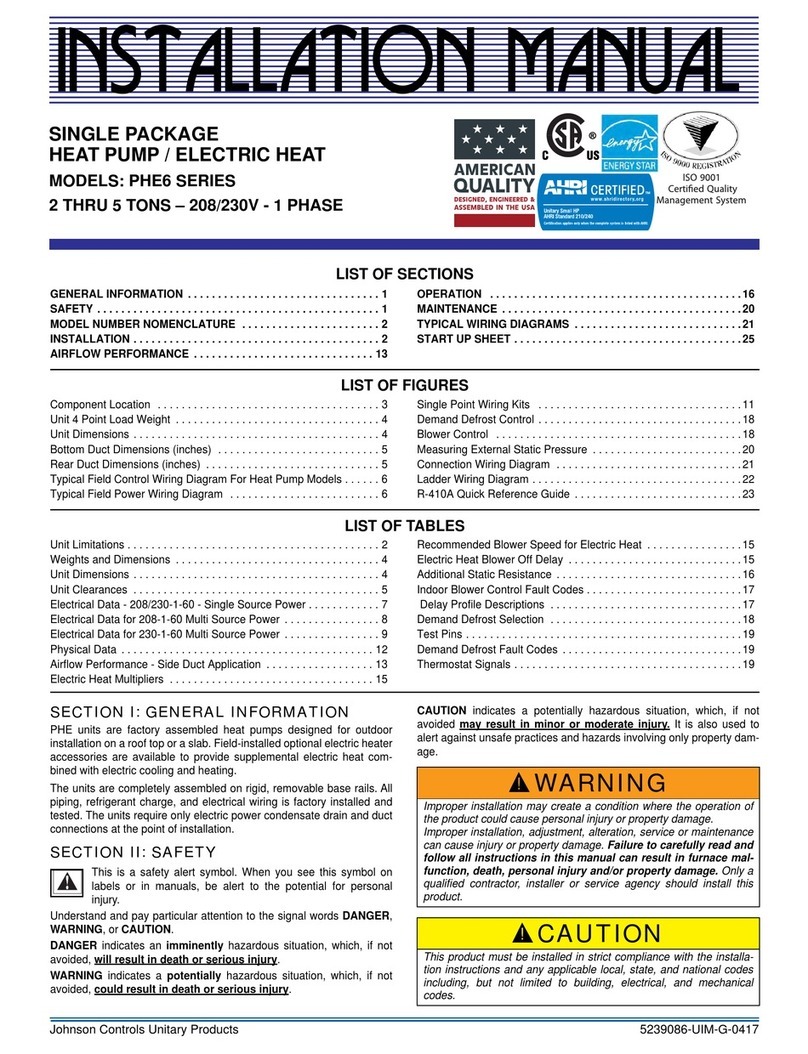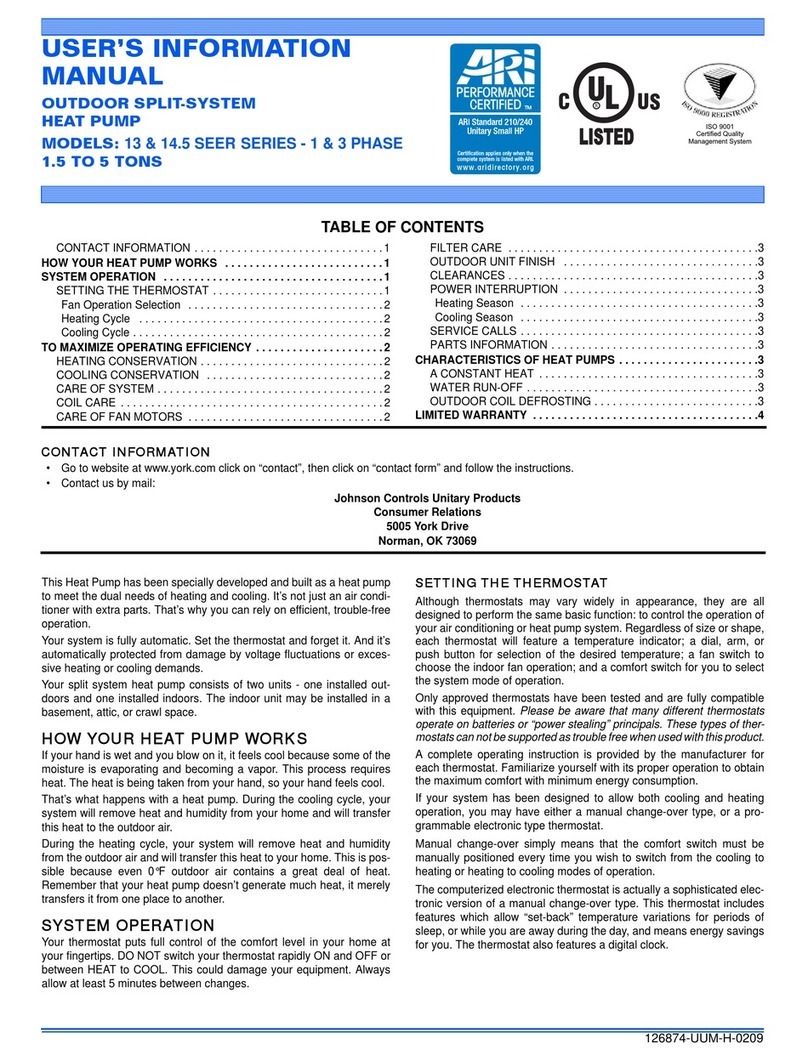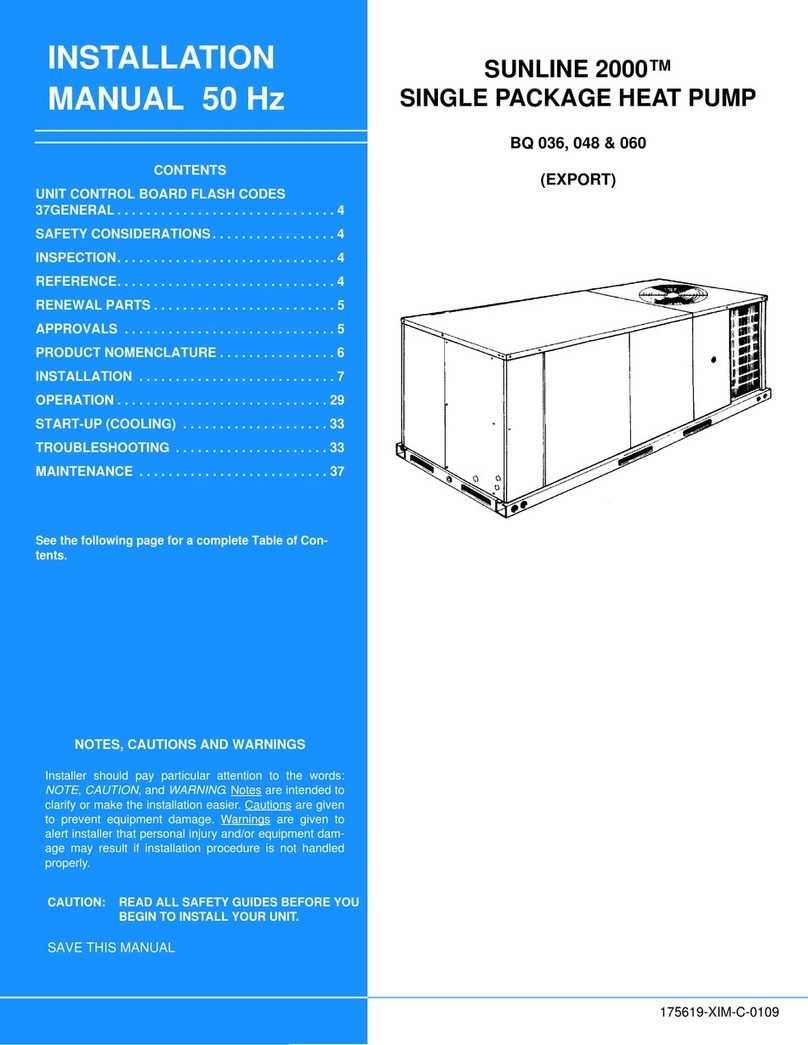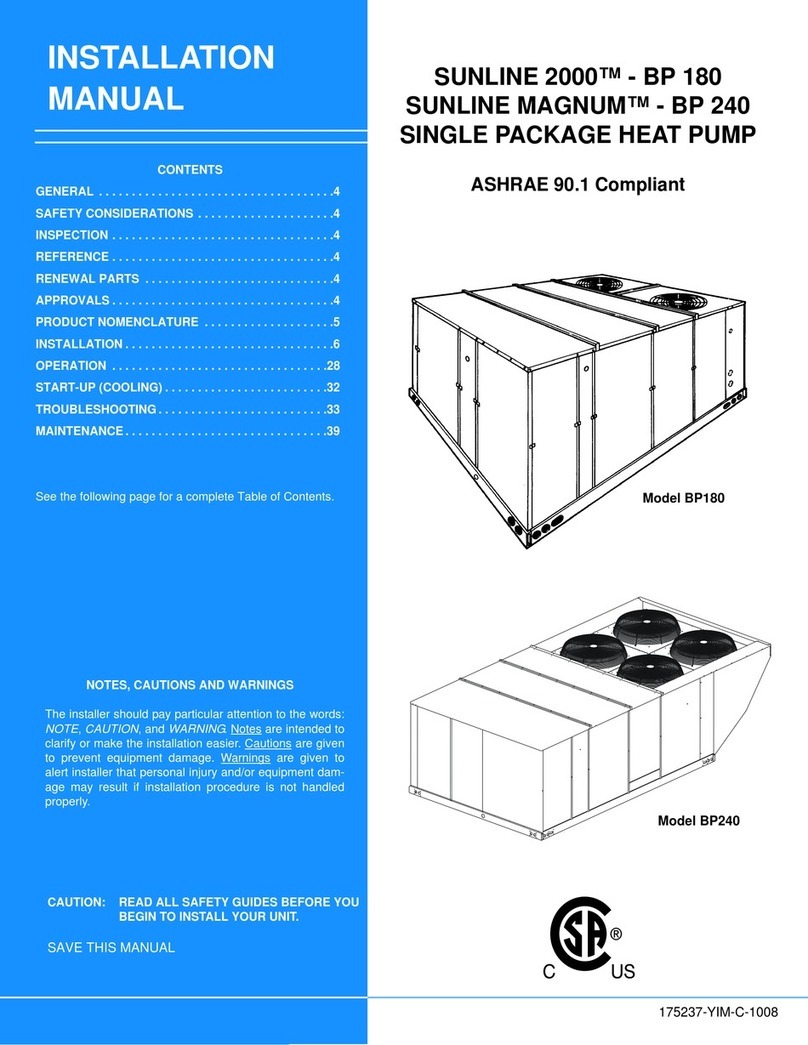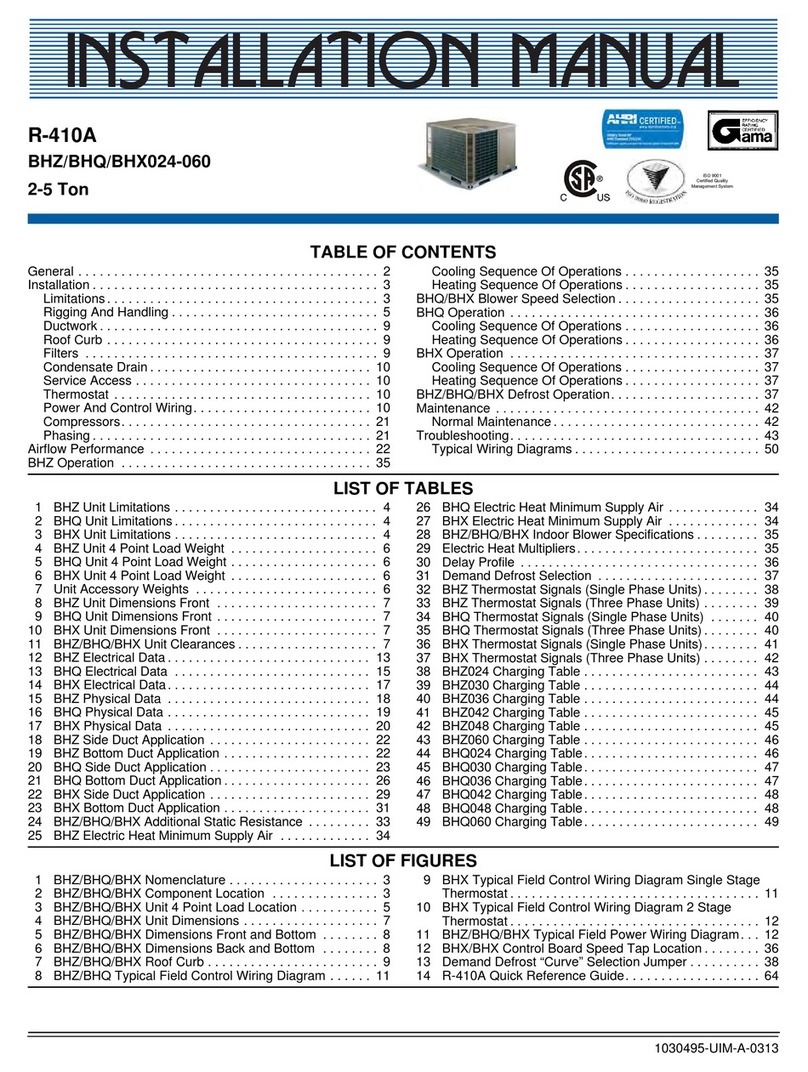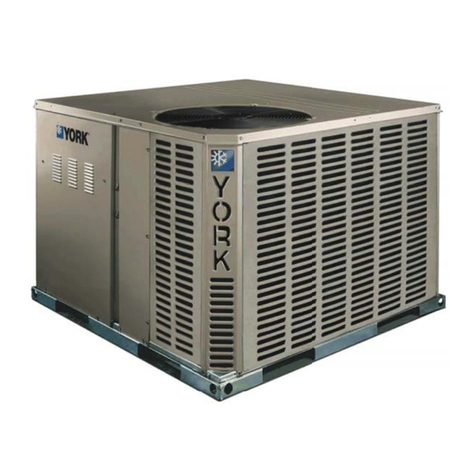
5132211-UUM-A-0815
4Johnson Controls Unitary Products
GENERAL MAINTENANCE
The manufacturer recommends that the furnace system be inspected
once a year by a licensed service person.
For proper and safe operation, the gas heating section needs air for
combustion and ventilation. Do not block or obstruct air openings on the
unit, nor the spacing around the unit. Keep the gas heating system area
clear and free of combustible materials, gasoline and other flammable
vapors and liquids.
Snow or debris should not be allowed to accumulate in or around the
unit. Do not permit overhanging structures or shrubs to obstruct con-
denser air discharge or vent outlet on your unit. These provide air for
combustion and ventilation.
FILTER CARE
Some units are shipped without a filter and it is the responsibility of the
installer to secure a filter in the return air ductwork or install a Filter/
Frame Kit.
Filters should be inspected and, if necessary, cleaned or replaced once
each month. If the location of the filter is not obvious, contact a qualified
service agency.
Filters must always be used and must be kept clean. When filters
become dirty, insufficient air will be delivered by the blower, decreasing
your units efficiency and increasing operating costs and wear-and-tear
on the unit and controls.
OUTDOOR COIL
Dirt should not be allowed to accumulate on the outdoor coil surface or
other parts in the air circuit. Cleaning should be done as often as neces-
sary to keep the coil clean. Use a brush, vacuum cleaner attachment, or
other suitable means. If water is used to clean the coil, be sure that the
power to the unit is shut off prior to cleaning. Do not use a high pressure
washer.
BURNERS
At the beginning of each heating season, make a visual check of the
main burner flame. The flame should be a light blue color. If yellow
flame is present, or if black soot can be seen, the burners may need to
be cleaned.
TO CLEAN BURNERS
Cleaning the burners should be performed only by a qualified service
agency.
FLUE DISCHARGE
Visually inspect discharge outlet periodically to insure soot and dirt
buildup is not excessive. If necessary, clean to maintain adequate com-
bustion air discharge.
The manufacturer recommends that the furnace system be inspected
once a year by a licensed service person.
CLEANING FLUE PASSAGES AND HEATING ELE-
MENTS
With proper combustion adjustment the heat exchanger of a gas fired
furnace will seldom need cleaning. If the heat exchanger should
become sooted, cleaning should be performed only by a qualified ser-
vice agency.
REGISTERS
Supply air and return air registers must be open when the unit is in
operation. Furniture must not block airflow in or out of the registers.
TROUBLESHOOTING
BEFORE CALLING A SERVICE PERSON:
1. Check thermostat setting and insure thermostat is calling for heat or
cooling.
2. Check thermostat for lint, dust, etc.
3. Check fuses or circuit breakers.
4. Check filters for excessive dust accumulation and/or restriction.
REPLACEMENT PARTS LIST
All components, assemblies, accessories, and replacement parts for
this furnace are available through qualified service agencies. It is not
recommended that the user purchase, install, or replace any compo-
nents of this furnace. Contact your local contractor, dealer, or service
provider for additional information.
WIRING DIAGRAM
The unit wiring diagram may be found on the inside of one of the access
panels on the furnace. It is intended for reference only. If service is
required, contact your local contractor, dealer, or service provider.
SOME EFFICIENCY DO'S AND DON'TS
DON'T heat or cool unused areas. Reduce supply and return air flow to
a minimum in areas which are not living spaces (storage rooms,
garages, basements, etc.).
DON'T be a “thermostat jiggler”. Moving your thermostat setting will not
make your system heat or cool any faster. Adjust your thermostat to a
comfortable setting and leave it there.
DON'T restrict air circulation. Placing furniture, rugs, etc. in such a way
that they interfere with air vents will make your system work harder to
achieve a comfortable temperature level. This requires more energy,
which means greater cost to you.
DON'T heat or cool when you are away. If you are going to be away for
a day or more, re-adjust your thermostat accordingly. Your furniture is
far less demanding than you are when it comes to comfort levels. How-
ever, don't expect the system to restore comfort conditions immediately
upon returning home. It will take a little time.
DON'T locate lamps or other heat producing appliances (radios, TV's,
heaters, etc.) near your thermostat. The heat from these items will give
your thermostat false information about the temperature in the room.
DO select a comfortable thermostat setting, but keep in mind that mod-
eration in temperature selection will save energy.
DO turn on your kitchen exhaust fan when cooking and your bathroom
exhaust fan when showering. Also, make sure your clothes dryer is
properly vented. If these items are neglected, an excess heat and
humidity condition may be created, causing your air conditioning sys-
tem to run longer.
DO set your thermostat a few degrees lower than normal several hours
before entertaining a large group of people in a relatively small area.
People give off a considerable amount of heat and moisture in a closed
area.
DO keep drapes and Venetian blinds closed when practical. These
items provide insulation against heat loss/gain.
DO contact a licensed service person to make repairs or adjustments to
your system. They have been trained to perform this service.
CAUTION
Exercise care when cleaning the coil so that the coil fins are not dam-
aged.
Do not permit the hot condenser air discharge to be obstructed by
overhanging structures or shrubs.
